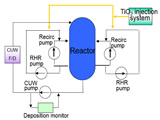Classification
5 - B (SCC Mitigation Method)
The stress corrosion cracking (SCC) susceptibility of boiling water reactor (BWR) components, such as stainless steel and Ni base alloy materials, is mitigated by the reduction of electrochemical corrosion potential (ECP). Current mitigation methods are hydrogen water chemistry (HWC) and noble metal chemical addition (NMCA). In these methods ECP reduction depends on the decrease of dissolved oxygen and hydrogen peroxide concentration and continuous hydrogen injection is necessary. Furthermore the ECP reduction effect varies depending on the location in the reactor and hydrogen injection rate. The TiO2 injection technique reduces the ECP of the components to mitigate the SCC without hydrogen injection as a lot of studies about TiO2 indicate [1]~[4]. The ECP reduction is achieved by photo-exciting reactions on the surface of the TiO2 under Cherenkov radiation regardless of the HWC and NMCA. Therefore the ECP reduction effectively occurs whole inside the reactor vessel throughout the operation. TiO2 deposition (treatment) on the reactor internals is made by TiO2 dilute solution addition in operation or at refueling outage. These effects were confirmed by lab tests and Halden reactor test [5], [6].
In this paper are described the measurement result of TiO2 deposition onto the reactor internals during the maintenance outage just after the TiO2 injection.
- (1) Components:
BWR core internals (core shroud, shroud support, jet pump, CRD housing and stub-tube, ICM housing, etc.)
- (2) Materials: Weld and heat affected zone of austenitic stainless steel and Ni base alloy
The schematic diagram of TiO2 injection system is shown in Fig.1 [5], [6]. TiO2 injection into BWR plants is performed during shutdown into RHR (Residual Heat Removal System) piping using TiO2 injection system. Reactor water is kept at high temperature during TiO2 solution injection. At the same time, TiO2 deposition is monitored by deposition monitor, and TiO2 concentration, conductivity, pH, impurity concentration in reactor water are analyzed. TiO2 can be effectively deposited on the surface of core internals by this system.

Fig.1 The schematic diagram of TiO2 injection system
5. Examples of Application
(1) TiO2 deposition amount on the reactor internals TiO2 injection was performed at Fukushima daini unit 1(2F-1) in June 2010 [6]. TiO2 solution was injected into both of RHR piping during shutdown at around 150°C for 30 hours. After that, metal depositions on core internal (inner and outer core shroud, CRD guide tube and RPV inner wall) were collected by scraping the surface during the outage and the TiO2 deposition density on core internals in the metal elements (Ti, Fe, Ni, Cr, Co, Cu) was analyzed by ICP-MS. The locations and the coolant velocities were shown in Fig. 2. It is widely recognized that the deposition coefficient is controlled by mass transfer coefficient which is a function of flow rate. At each location two types of scraping devices (brush and Scotch-Brite™) were used to remove both soft crud and hard crud. The result shows that TiO2 deposition densities are more than 15μg/cm2 which is enough to mitigate SCC susceptibility [7]. The measurement results were shown in Fig. 3.

Fig.2 The crud scraping Locations and the coolant surface velocity at each location

Fig.3 The deposition amount of TiO2 at each location inside the reactor vessel
(2) Fuel surveillance program Fuel surveillance program was performed to evaluate the side effect of TiO2 for fuel [7]. The new fuel bundles that were TiO2 splay coated were loaded to the reactor of 2F-1. After 1 cycle operation (around 13 months), the visual observation, the metal oxide thickness measurement by eddy current method for the fuel bundles were performed in the outage. No significant adverse effect for the fuel was seen. Furthermore, water chemistry and plant parameters were investigated during the injection and starting up the plant, and in operation with full power. No significant change for them was seen so far. TiO2 injection was successfully performed at Japanese BWR plant without adverse effect.
6. Reference
- [1]K.Takamori et al., “Corrosion Mitigation of BWR Structural Materials by the Photoelectric Method with TiO2 - A SCC Mitigation Technique and its Feasibility Evaluation -”, 12th International Conference on Environmental Degradation of Materials in Nuclear Power Systems-Water Reactors, TMS 2005
- [2]Y.Fukaya et al., “Photoelectrical Protection of Stainless Alloys in BWR Primary Coolant Environment”, 10th International Conference on Environmental Degradation of Materials in Nuclear Power Systems-Water Reactors, NACE 2001
- [3]K.Takamori et al., “Development of BWR Components SCC Mitigation Method by the TiO2 Treating Technique”, 13th International Conference on Environmental Degradation of Materials in Nuclear Power Systems-Water Reactors, TMS 2007
- [4]J.Suzuki et al., “Development of SCC Mitigation Method in BWR Plant by TiO2 Technique”, 15th International Conference on Nuclear Engineering, April 22-26, 2007, Nagoya, Japan
- [5]“SCC mitigation method by TiO2 technique”, Japan Society of Maintenology, E-Journal of Advanced Maintenance (EJAM), Vol.2, No.4, NT32, 2011
- [6]K.Koyabu et al., “Application of the SCC Mitigation Method with TiO2 to BWR plant”, Atomic Energy society of Japan (AESJ) Annual meeting, 2011
- [7]M. Okamura et al., “Corrosion Mitigation of BWR Structural Materials by the Photoelectric Method with TiO2 -Laboratory Experiments of TiO2 Effect on ECP Behavior and Materials Integrity-”, Proc. of the 12th International Conference on Environmental Degradation of Materials in Nuclear Systems - Water Reactors, August 14-18, 2005, Salt Lake City, Utah, USA, TMS (2005).
Japan Society of Maintenology (ejam@jsm.or.jp)



